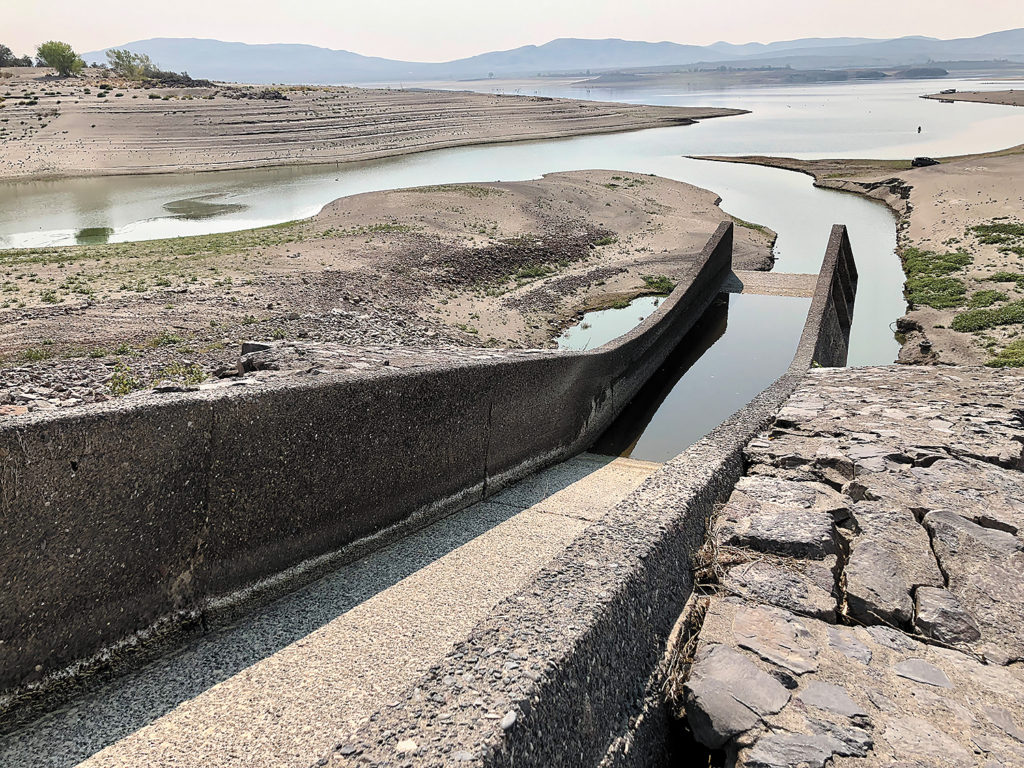
This is a current photo of the Carson Riverbed just before water (if it were flowing) would enter the Lahontan Reservoir. The Carson River originates in the Sierra Mountains south of Lake Tahoe.
Nevada has never been known to be a state with an abundant water supply. In fact, Nevada is ranked as the driest state in the United States with an average annual precipitation of only 10 inches. With the diverse landscape of Nevada ranging from snowy mountain tops to sandy deserts and sagebrush valleys in between, the actual precipitation received is closer to 4 inches for most of the state. With the high mountain tops receiving closer to 50 inches of snowfall or more in a good winter.
With the average precipitation totals it’s no surprise that 100% of the state is in a D1-Moderate drought, 95.2% is in a D2-Severe Drought, 67.6% is in a D3-Extreme Drought and 25.9% is in a D4-Exceptional Drought. It’s a perfect example of how diverse the state is but is worrisome for the over 3,400 farms and ranches based in the Silver State.
When people think of Nevada their first thought is often Las Vegas. Nevada is made up of 17 counties 13 of which are classified as rural. Agriculture is one of the leading contributors to rural economies throughout the state with alfalfa hay being the leading cash crop.
Other agriculture throughout the state includes range livestock (of cow-calf or sheep operations), dairy, alfalfa hay, alfalfa seed, grass hay, potatoes, barley, winter and spring wheat, corn, oats, onions, garlic and honey.
Most of the crops grown throughout the state are not as water intensive as some found in other states, but that does not make the lack of water any less crucial to the success of agriculture here. Adapt and adjust is what many have learned to do as the drought seems to only be getting worse with the added impacts of rising temperatures.
Nevada Farm Bureau Vice President Darrell Pursel has endured first-hand how dire the need for water is. Pursel a Lyon County alfalfa farmer and a cow-calf rancher expresses his frustration with how the lack of water has affected his year so far, “it seems we are working hard or harder to get nothing or very little at all.”
Many farmers throughout the state have wells or rely on water from reservoirs and rivers. If you have a well, you are continuing with business mostly close to “normal”. If you rely on water from other sources like surface water flows from reservoirs and rivers like Pursel and other producers in the same situation, you are greatly feeling the impacts. Those receiving irrigation water from surface sources throughout the state have received less water allocation than normal and have had their water completely shut off early this year. Early anticipation of drought conditions made many farmers fear this year would be tough. Many pivoted in launching alternative production options, targeting priority crops or more productive fields, planted less or left some fields not planted at all.
Expecting drought and adapting doesn’t make it any easier for the farmers and ranchers. For Pursel he is anticipating having 1/3 of his normal alfalfa to sell. In addition to having less alfalfa to sell the beef cattle are anticipated to weigh 100 pounds less than normal. Without the water supply there just isn’t the pasture the cows are used to grazing on, which means supplementing more with alfalfa.
“Learning to adapt is the hardest thing. I am used to doing custom work on top of the alfalfa I sell for extra income and with such little water I have had to focus on just the alfalfa to keep everything afloat,” said Pursel. “I don’t know what we will do if we don’t get moisture this winter. It’s better to not think about that yet.”
For those who aren’t as lucky to have hay on hand the situation is much more dire with hay prices up and it also being hard to find. The thought of lasting through the winter seems to be worrisome for some. That will be the true test if many can survive past the winter with the rough summer we have already have.
From one area of the state to the other everyone’s story seems to be the same if you have hay you are in great shape. Hopefully your hay supply can survive the drought, or at least the winter. Even more if you have a well and are growing alfalfa with extra to spare, and prices at premium, you are in even better shape.
Winter will be an anxious time for farmers and ranchers across Nevada. As we hope for moisture throughout the state the next few months will be the true indicator of how impactful this dry year truly was.
The Lahontan Reservoir is a part of the first reclamation project – the Newlands Irrigation project – completed in the United States. This reservoir has a capacity to hold 295,500 acre feet of water (an acre foot of water is just under 325,000 gallons of water). Lahontan Reservoir receives waters from the Carson River and under specified conditions through a diversion of the Truckee River. The Carson River system has its headwaters in the Sierra Mountains, just south of Lake Tahoe and the Truckee River originates from Lake Tahoe and flows through the Reno/Sparks area before reaching the Derby Dam diversion east of Reno/Sparks. When Truckee River water isn’t being diverted it flows to Pyramid Lake. This year’s irrigation season was concluded in mid-August when water levels fell below the minimum pool requirements to be kept in the reservoir.
The Newlands Irrigation project covers 57,000 acres of cropland and was authorized by Congress in 1903.The first irrigation season for the project was in 1905 and the Lahontan Dam which holds the waters in the Lahontan Reservoir before distribution through irrigation canals was completed in 1914.
By Brittney Money | NFB, Director of Communications


